May is considered a birdwatcher’s favorite month, and it’s easy to get impatient for the arrival of the neotropical passerines in spring. After more than 6 months without seeing the shimmering colors of the warblers, the wait can even seem interminable. Everyone starts predicting their arrival date or interpreting the early or late arrival of certain species. But what is certain is that almost everyone agrees that every year is strange, and certainly very different from the previous year. But what if it’s just our imagination? Or a combination of environmental factors?
Regional differences
Looking at southern Quebec, with nearly twenty species of warbler, and several record-breaking arrival dates, it might be easy to conclude that we’re experiencing an early spring. On the Côte-Nord, on the other hand, some birds didn’t seem in such a hurry to arrive. But why? There may be several reasons for the early arrival of some species and a delay in others, but here are two to ponder:
– Birds prefer favorable winds to travel, i.e. southerly winds, and generally avoid precipitation. Depending on their migratory stopovers, some will be able to move further north, others not.
– It can be advantageous to migrate early to get to a territory first, but it’s also a risky gamble if conditions deteriorate or food runs short.


Tools for monitoring migration
To help us think things through, we can use the multitude of applications and websites now available to us.
– Windy is an application that focuses primarily on wind, as its name suggests, but also includes more and more meteorological data. You’ll be able to see forecasts of wind intensity and direction for the week ahead, with an accuracy of 3 hours for the free option.
– GLAM is a NASA site that shows NDVI anomalies, i.e. the difference between near-infrared light (which vegetation strongly reflects) and red light (which vegetation absorbs). We can see, for example, that for a large area of southern Quebec as far as Trois-Rivières, as well as some places further north, vegetation appears to be ahead of schedule (in green). The same is true for the Lower St. Lawrence, compared with the rest of the Gaspé Peninsula and the North Shore, which are in red (and therefore behind schedule).
– Paul J. Hurtado’s blog uses data from the Athmospheric and Oceanic Sciences, University of Wisconsin-Madison, to make use of radar data, on which bird movements, in addition to precipitation, can be observed on the move. Unfortunately, this data is still only available for the United States, but it’s interesting to note that birds can cover several hundred kilometers in a single night. Keep an eye on the Quebec border, if you see a multitude of small dots on the move at night.
What are the consequences?
Although arrival records are being broken, what we’re generally seeing is greater variability in environmental conditions, and therefore in the birds’ arrival dates. This variability can have major consequences for the survival and reproduction of birds, as well as for their migratory strategies.
Can we expect a mega reverse migration?
If you’ve never heard of this phenomenon, we invite you to read our Visual surveys section.
Since 2018, the Tadoussac dunes have been under surveillance from May 5 to June 6 to document and try to better understand this exceptional phenomenon. Since then, several days with more than 10,000 birds have been documented and made the headlines in several international newspapers (The New York Times 2018, Bird Watcher’s Digest 2023, Birdwatch 2024). Hundreds of thousands of birds on the move to the southwest bring their own set of questions, and it remains difficult, if not impossible, to predict with any certainty that such a scenario will occur again. On the other hand, in recent years, the number of warblers that make up the vast majority of birds moving southwest has been particularly high, not least because of the spruce budworm on which they feed. The spruce budworm is still very present on the Côte-Nord and in Charlevoix. On the other hand, due to the delayed emergence of vegetation in these two regions, as well as weather conditions that did not favor large-scale movements, a large proportion of neotropical passerines are mainly confined to southern Quebec.

Birds by the thousands
Although this information is favorable for a major migration from May 20 onwards, it is mainly the weather conditions that will determine whether or not this massive movement of birds takes place. It remains impossible to guarantee that such an event will occur again this year, especially on the scale of 2018. As we’ve seen in the past, conditions are generally favorable for such a movement, with southerly winds overnight, followed by northwesterly winds the next day. In any case, we invite you to come and discover or rediscover this research project on the Tadoussac dunes and we hope you will see thousands of birds with us.
The project is entirely dependent on your donations, and you can help keep it going. Thank you for your support!

